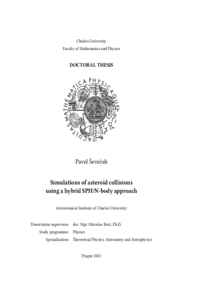Simulations of asteroid collisions using a hybrid SPH/N-body approach
Simulace srážek asteroidů pomocí hybridní SPH/N-částicové metody
dizertační práce (OBHÁJENO)

Zobrazit/
Trvalý odkaz
http://hdl.handle.net/20.500.11956/152371Identifikátory
SIS: 177934
Kolekce
- Kvalifikační práce [11968]
Autor
Vedoucí práce
Oponent práce
Kobayashi, Hiroshi
Schäfer, Christoph M.
Fakulta / součást
Matematicko-fyzikální fakulta
Obor
Teoretická fyzika, astronomie a astrofyzika
Katedra / ústav / klinika
Astronomický ústav UK
Datum obhajoby
29. 9. 2021
Nakladatel
Univerzita Karlova, Matematicko-fyzikální fakultaJazyk
Angličtina
Známka
Prospěl/a
Klíčová slova (česky)
hydrodynamika|asteroidyKlíčová slova (anglicky)
hydrodynamics|asteroidsVýzkum srážek asteroidů je zásadní pro pochopení vzniku a vývoje Sluneční soustavy. K interpretaci pozorování více než 100 rodin asteroidů se využívá nu- merických simulací. V této práci používáme metodu shlazených částic (SPH), která umožňuje detailně popsat impakt, šíření rázové vlny, fragmentaci aster- oidu, výhoz fragmentů a reakumulaci vlivem gravitace a vzájemných kolizí. Vzh- ledem k tomu, že příslušná časová škála může dosáhnout doby oběhu tělesa, je metoda SPH často spojena s N-částicovým integrátorem, který nahrazuje hy- drodynamiku za detekci kolizí. V první části práce popisujeme použité num- erické metody a jejich implementaci v novém kódu OpenSPH. Důkladně také kód testujeme, používáme přitom analytická řešení a laboratorní experimenty jako referenci. Dále diskutujeme stabilitu metody a její konvergenci vzhledem k prostorovému rozlišení. V recenzovaných článcích, zahrnutých v této práci, se zaměřujeme na srážky s terči konkrétních velikostí (D = 10 a 100 km). Zk- oumáme závislost na velikosti terče, velikosti projektilu, rychlosti impaktu, im- paktním úhlu a zejména na počáteční rychlosti rotace. Ukazujeme, že rotace může výrazně redukovat efektivní pevnost terče a...
Understanding asteroid collisions is a key part of Solar System science. To in- terpret observations of more than 100 asteroid families, various numerical sim- ulations are used. In this work, we prefer the smoothed particle hydrodynamics (SPH), which allows a detailed description of impact mechanics, shock wave propagation, fragmentation of the target, ejection, or reaccumulation controlled by self-gravity and secondary collisions. Since the respective time scale may reach the orbital time scale, the SPH is often complemented by efficient N-body integrators and collisional handlers. In the review part of the thesis, we describe details of numerical methods and their implementation in the new OpenSPH code. We also thoroughly test the code, using analytical solutions and labora- tory experiments as references, and discuss its stability and convergence with respect to spatial resolution. In the refereed papers, included in the thesis, we focus on collisions with targets of particular sizes (D = 10 and 100 km). We explore the dependence of outcomes on the target size, the projectile size, the impact speed, the impact angle, and most importantly, the initial spin rate. We demonstrate that rotation significantly decreases the effective strength of the targets and increases the ejected mass. We self-consistently...
